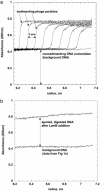Osmotic pressure inhibition of DNA ejection from phage
- PMID: 12881484
- PMCID: PMC170911
- DOI: 10.1073/pnas.1233721100
Osmotic pressure inhibition of DNA ejection from phage
Abstract
Bacterial viral capsids in aqueous solution can be opened in vitro by addition of their specific receptor proteins, with consequent full ejection of their genomes. We demonstrate that it is possible to control the extent of this ejection by varying the external osmotic pressure. In the particular case of bacteriophage lambda, the ejection is 50% inhibited by osmotic pressures (of polyethylene glycol) comparable to those operative in the cytoplasm of host bacteria; it is completely suppressed by a pressure of 20 atmospheres. Furthermore, our experiments monitor directly a dramatic decrease of the stress inside the unopened phage capsid upon addition of polyvalent cations to the host solution, in agreement with many recent theories of DNA interactions.
Figures



References
Publication types
MeSH terms
Substances
LinkOut - more resources
Full Text Sources
Other Literature Sources

